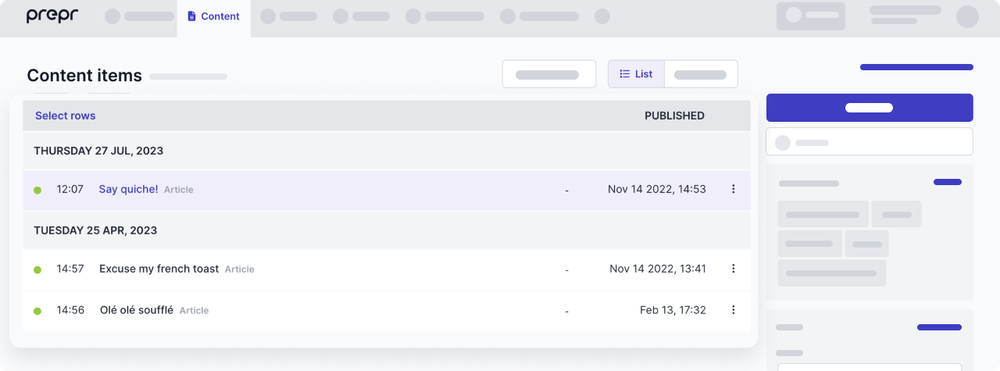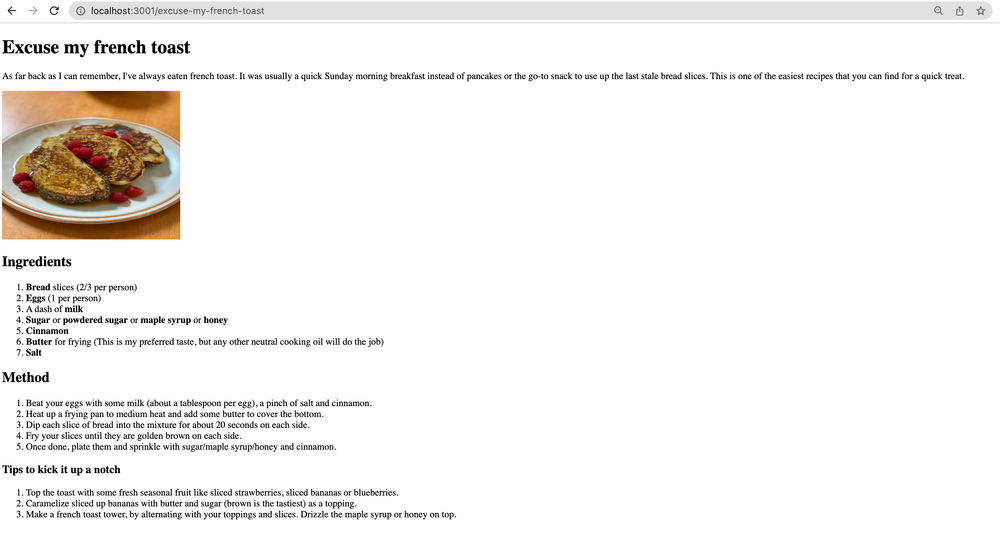React Quick start guide
Estimated duration: 10 minutes
This guide shows you how to connect Prepr to a React project to get data from Prepr CMS. You’ll learn how to make a simple blog with React and Prepr CMS. By the end of this guide, you’ll have a working app that looks like the image below.

If you want to skip ahead, try out the zero installation demo on Stackblitz or clone the repository on GitHub to run the demo locally.
Prerequisites
You need to have the following setup before you connect your React project to Prepr.
Step 1: Create a new React project
The instructions below will guide you on how to create an empty React project for your blog app.
Install React
You can skip this step if you have an existing React project.
- Open a terminal and execute the command below to create a new React project called
prepr-react.
npx create-react-app prepr-reactThe create-react-app package is no longer being maintained. Check out the React docs for more details. Also check out our Next Quick start guide to create a new project with a recommended React framework.
- Now that the project is successfully created, go to the
prepr-reactfolder, the root directory of the project, and start the project with the following commands in the terminal:
cd prepr-reactnpm start-
You should now be able to view your app on your localhost, for example,
http://localhost:3000/. -
Open your project with your preferred code editor.
-
Update
App.jsin thesrcfolder with the following code to display your blog:
import './App.css';
function App() {
return (
<div>
<h1>My blog site</h1>
</div>
);
}
export default App;You should now see something like the image below on your localhost.

Step 2: Install Apollo Client
Apollo Client is an integration tool that helps to retrieve CMS data with GraphQL. The instructions below show you how to install Apollo Client so that you can add GraphQL queries to request data from the Prepr API.
- Stop the server you started in the above step (
CTRL-C) and execute the following command in the terminal:
npm install @apollo/client graphql- Go to the
srcfolder and create aservicesfolder. Then, create a file calledapollo-client.jsin this folder. Copy the following code to this file to import and initialize Apollo Client:
import { ApolloClient, InMemoryCache } from "@apollo/client";
const client = new ApolloClient({
uri: `https://graphql.prepr.io/${process.env.REACT_APP_PREPR_ACCESS_TOKEN}`,
cache: new InMemoryCache(),
});
export default client;This client will be used to make API requests to endpoints provided by the Prepr CMS across your React application.
- We recommend using environment variables to store sensitive information like access tokens. To add environment variables, create a
.envfile in the root directory of your project and add the access token like this:
REACT_APP_PREPR_ACCESS_TOKEN=<YOUR-ACCESS-TOKEN>- Replace the placeholder value
<YOUR-ACCESS-TOKEN>with an access token from Prepr. Get an access token by logging into your Prepr account:
a. Click the icon and choose the Access tokens option to view all the access tokens.
b. Copy the GraphQL Production access token to only retrieve published content items on your site.

Use the GraphQL Production access token to request published content items for your live app and use the GraphQL Preview token to make a preview of unpublished content items for your content editors.
- Update the
index.jsfile in thesrcfolder to add theApolloProvidercomponent with the following code:
import React from 'react';
import ReactDOM from 'react-dom/client';
import App from './App';
import {createBrowserRouter, RouterProvider} from "react-router-dom";
// Import the Apollo Provider and Apollo Client
import {ApolloProvider} from "@apollo/client";
import client from "./services/apollo-client";
const root = ReactDOM.createRoot(document.getElementById('root'));
const router = createBrowserRouter([
{
path: "/",
element: <App />,
},
]);
// Add the ApolloProvider
root.render(
<React.StrictMode>
<ApolloProvider client={client}>
<RouterProvider router={router}/>
</ApolloProvider>
</React.StrictMode>
);- Install the React Router DOM package to enable routing with the following command:
npm install react-router-dom@6- Execute the following commands to make sure that Apollo Client is installed correctly:
npm install
npm startIf your app runs without errors, then the setup above was done correctly. The next step is to fetch content from Prepr using the installed Apollo client.
Step 3: Fetch multiple articles
Now that Apollo Client is installed and connected to Prepr, fetch the blog articles from Prepr.
Add a GraphQL query
- Go to the
srcfolder, create aqueriesdirectory and create a file namedget-articles.js. - Add the following query to this file to retrieve all articles:
import { gql } from "@apollo/client";
export const GetArticles = gql`
query {
Articles {
items {
_id
_slug
title
}
}
}
`You can create and test GraphQL queries using the Apollo explorer from Prepr. Open the API Explorer from the Article content item page in Prepr or the access token page.
If you’re using preloaded demo data in your Prepr CMS environment as mentioned above in the Prerequisites section, you should have a few published articles as shown in the below image. The query will retrieve the ID, Slug, and Title of each article.

In the next step, we’ll fetch and process the query response.
Fetch data
Now that the query has been added, fetch the articles from Prepr and display them in the app.
- Open the
App.jsfile in thesrcfolder and replace the content with the code below to display the data retrieved from the query.
import React from "react";
// Import the query and the apollo client
import {GetArticles} from "./queries/get-articles";
import {useQuery} from "@apollo/client";
function App() {
// Execute the query
const {loading, error, data} = useQuery(GetArticles);
if (loading) return <p>Loading...</p>;
if (error) return <p>Error :(</p>;
// Set the query results
const articles = data.Articles.items;
return (
<div>
<h1>My blog site</h1>
<ul>
{articles.map((article) => (
// List the fetched articles
<li key={article._id}>
{article.title}
</li>
))}
</ul>
</div>
);
}
export default App;Now when you view the website on your localhost, you’ll see something like the image below.

Step 4: Fetch individual articles
Now that you have the list of articles, add links to them. When a visitor clicks on a link, your app should open a detailed article page automatically. The instructions below show you how to set up the routing from the main page to the detailed page and how to fetch the article details based on the slug of the article that was clicked.
Add links
- Update the
App.jsfile to include a link tag on each article title as shown in the code below.
import React from "react";
import {GetArticles} from "./queries/get-articles";
import {useQuery} from "@apollo/client";
// Import Link to enable links in the HTML
import {Link} from "react-router-dom";
function App() {
const {loading, error, data} = useQuery(GetArticles);
if (loading) return <p>Loading...</p>;
if (error) return <p>Error :(</p>;
const articles = data.Articles.items;
return (
<div>
<h1>My blog site</h1>
<ul>
{articles.map((article) => (
<li key={article._id}>
{/* Add links to the article title */}
<Link to={article._slug}>{article.title}</Link>
</li>
))}
</ul>
</div>
);
}
export default App;Now when you view the app, each article has its own link. When you click on the link, a new page opens with the slug in the URL, but a Page 404 error is displayed. Continue with the next step to fetch the article details and resolve this error.
Fetch article details
Add another query to fetch a specific article by its slug and make this page visible when clicking on an article.
- Create a file called
get-article-by-slug.jsin thequeriesfolder and add the following to query a specific article by its slug:
import { gql } from "@apollo/client";
export const GetArticleBySlug = gql`
query ($slug: String) {
Article (slug: $slug) {
_id
title
content {
__typename
... on Text {
body
text
}
... on Assets {
items {
url
}
}
}
}
}`Now that the query is added, fetch the individual article by its slug. Fetch the article title and the article content.
The Article content is stored in a Dynamic content field. Check out the GraphQL docs for more details on how to fetch the data within this field.
- Go to the
srcfolder and create a new file calledArticlePage.jswith the code below to fetch an article by its slug and display the article details.
import React from "react";
import {useQuery} from "@apollo/client";
// Import the query and the apollo client
import {GetArticleBySlug} from "./queries/get-article-by-slug";
import {useParams} from "react-router-dom";
export default function ArticlePage() {
// Get the slug from the URL
const {slug} = useParams();
// Execute the query
const {loading, error, data} = useQuery(GetArticleBySlug, {
variables: {slug}
});
if (loading) return <p>Loading...</p>;
if (error) return <p>Error :(</p>;
const article = data.Article;
return (
<>
<h1>
{ article.title }
</h1>
{/* Loop through content types in article content */}
{article.content.map((contentType) => {
// Display image if it exists
if (contentType.__typename === 'Assets' && contentType.items.length) {
return (
<div className="my-10">
<img
src={contentType.items[0]?.url}
width="300"
height="250"
alt={`Image for ${article.title}`}
/>
</div>
)
}
// Display text as HTML
if (contentType.__typename === 'Text') {
return (
<div dangerouslySetInnerHTML={{ __html: contentType.body }}></div>
)
}
})}
</>
)
}- Finally, update the
index.jsin thesrcfolder to include the route to the new article page with the following code:
import React from 'react';
import ReactDOM from 'react-dom/client';
import App from './App';
// Import the article page
import ArticlePage from "./ArticlePage";
import {createBrowserRouter, RouterProvider} from "react-router-dom";
import {ApolloProvider} from "@apollo/client";
import client from "./services/apollo-client";
const root = ReactDOM.createRoot(document.getElementById('root'));
const router = createBrowserRouter([
{
path: "/",
element: <App />,
},
// Add a route to the article page
{
path: "/:slug",
element: <ArticlePage />,
}
]);
root.render(
<React.StrictMode>
<ApolloProvider client={client}>
<RouterProvider router={router}/>
</ApolloProvider>
</React.StrictMode>
);Now, when you view your site, you can click on an article which will direct you to that specific article like in the image below.

All done
Congratulations! You have successfully connected a React project to Prepr for a simple Blog app.
Next steps
To learn more on how to expand your project, check out the following resources: